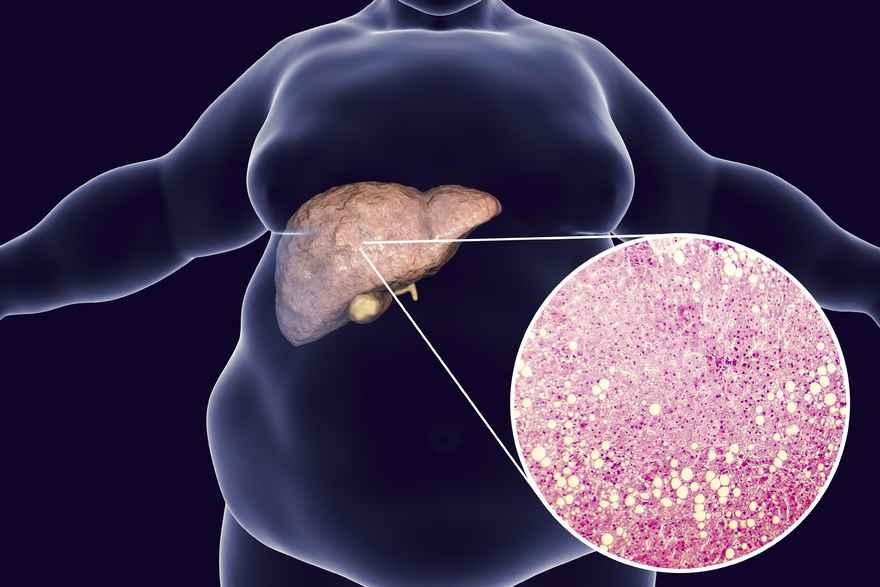
Fatty liver disease now affects up to 46% of the population. (1)
What was once a rare medical condition (more or less isolated to alcoholic populations) is now a "public health crisis" as stated in Open Health Journal published October 2017. (1)
This blunt article goes on to say:
“Data from animal and human studies implicate added sugars… Fructose, in particular, a component of added sugars, may pose the greatest risk for fatty liver disease.” (1)
This should come as no surprise since chefs know that the gourmet food known as “foie gras” (fatty goose liver) is created by feeding ducks and geese excessive amounts of corn. The fructose in the corn creates the fatty liver. We also know that bears fatten up by binge eating fruit prior to hibernation. Fructose does not convert to fat in the liver (nor to fat in other parts of our body) by accident. It converts to fat by design. The more fructose we eat, the more fat we accumulate.
There are 2 types of fatty liver disease.
- One is caused by the overconsumption of alcohol (Fatty Liver Disease)
- and another is caused by the overconsumption of fructose (Non-Alcoholic Fatty Liver Disease), especially fructose that is in 'free' form such as table sugar, fruit juice, high fructose corn syrup, agave, etc.
When we consume foods or drinks that contain fructose it is absorbed into the bloodstream from the small intestine and travels directly to the liver for processing via the portal vein. Glucose, on the other hand, bypasses the liver and can be readily used by our cells. These two sugars are metabolized differently and cause unique problems when consumed in excess.
Here’s the problem with fructose.
Historically we consumed fructose in the form of seasonal whole fruit. Fruit, among other benefits, was useful in helping us gain weight to survive winter months.
Today, we are blasting our bodies with concentrated 'free' fructose in high doses all year around. This grotesque excess ingestion of fructose is hard on the liver because it is responsible for converting sugar to glucose, then to glycogen, then to fatty acids which are then stored as fat (including in the liver).
Over time our liver cells get fatter and fatter until we develop Non-Alcoholic Fatty Liver Disease (NAFLD) impairing the function of one of our most important organs.
Signs and symptoms of a fat sluggish liver can be:
Skin issues, blemishes, headaches, migraines, digestion issues, burping, belching, yellow/blood shot eyes, nausea, constipation, low immunity, etc.
Most of these symptoms we ignore or medicate.
If we do not reverse NAFLD, (through diet, fasting and exercise) it can progress and become Non-Alcoholic Steatohepatitis (NASH).
NASH is a fatty and inflamed liver with scarring. Once the liver is scarred, blood flow will eventually be cut off. People with NASH often develop cirrhosis and require a liver transplant independent of alcohol use.
Bottom line...
It is perfectly fine for most of us to eat whole fruits and vegetables (sources of fructose) in season. But it is a health disaster for us to be eating fructose in free form. This means we can eat a whole orange but should never drink a glass of orange juice (which contains the fructose load of 8-10 oranges in one sitting).
If you do not want to turn your liver into fois gras, impairing its ability to detoxify your body (among hundreds of other awesome functions), stop eating processed foods that are laced with sugars which almost always contain free fructose.
There can be a point of no return with eating sugar. Your liver can shut down, and it's lights out.
—Florence
SOURCES:
https://openheart.bmj.com/content/4/2/e000631
https://www.activebeat.com/diet-nutrition/10-ways-eating-sugar-poses-danger-to-your-health/
https://www.webmd.com/diabetes/features/how-sugar-affects-your-body
https://www.healthline.com/nutrition/sucrose-glucose-fructose#absorption-and-use
Comments